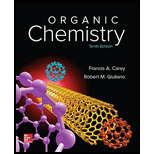
Interpretation:
The product(s) of each of the given reactions are to be determined.
Concept Introduction:
Hydrolysis of a peptide with a
Treatment of a peptide with phenyl isothiocyanate protects the N terminus of the chain. Subsequent treatment with a strong acid in anhydrous conditions cleaves only the amide bond between the protected amino acid residue and the rest of the peptide chain.
Benzyloxycarbonyl chloride is used to protect the
Hydrogenolysis with hydrogen over palladium is used for deprotection of N terminus.
Want to see the full answer?
Check out a sample textbook solution
Chapter 26 Solutions
ORGANIC CHEMISTRY-W/ACCESS >CUSTOM<
- Give the amino acid sequence of hexapeptides that produce the following sets of fragments upon partial acid hydrolysis: (a) Arg, Gly, Ile, Leu, Pro, Val gives Pro-Leu-Gly, Arg-Pro, Gly-Ile-Val (a) N, L, M, W, V2 gives V-L, V-M-W, W-N-Varrow_forwardAn unknown decapeptide was isolated and characterized. Complete hydrolysis of this peptide gave : F(2), A,G,C,K,N,T, W and V. Treatment with carboxypeptidase releases A. Reaction with Edman’s reagent gave PTH-T and a nonapeptide. The nonapeptide was treated with trypsin and gave 2 peptides: (V-C-G-A) and (N-FF-W-K). Give the sequence of amino acid in the decapeptide.arrow_forwardBradykinin is a linear nonapeptide released by blood plasma globulin in response to a wasp sting. It is a very potent pain-causing agent. Its constituent amino acids are 2R, G, 2F, 3P, S. The sue of 2,4-dinitrofluorobenzene and carboxypeptidase shows that both terminal residues are arginine. Partial hydrolysis of bradykinin gives the following di- and tripeptides: FS + PGF +PP + SPF + FR + RParrow_forward
- Determine the amino acid sequence of a polypeptide from the following data:Acid-catalyzed hydrolysis gives Ala, Arg, His, 2 Lys, Leu, 2 Met, Pro, 2 Ser, Thr, and Val.Carboxypeptidase A releases Val.Edman’s reagent releases PTH-Leu.Treatment with cyanogen bromide gives three peptides with the following amino acid compositions:1. His, Lys, Met, Pro, Ser 2. Thr, Val 3. Ala, Arg, Leu, Lys, Met, Serarrow_forwardDetermine the amino acid sequence of a polypeptide from the following data: Acid-catalyzed hydrolysis gives Ala, Arg, His, 2 Lys, Leu, 2 Met, Pro, 2 Ser, Thr, and Val. Carboxypeptidase A releases Val. Edman’s reagent releases PTH-Leu. Treatment with cyanogen bromide gives three peptides with the following amino acid compositions: 1. His, Lys, Met, Pro, Ser 2. Thr, Val 3. Ala, Arg, Leu, Lys, Met, Ser Trypsin-catalyzed hydrolysis gives three peptides and a single amino acid: 1. Arg, Leu, Ser 2. Met, Pro, Ser, Thr, Val 3. Lys 4. Ala, His, Lys, Metarrow_forwardA nonapeptide released by globulins in the blood in response to a waspsting. Hydrolysis gives the following amino acids: 2 Arg, Gly, 2 Phe, 3 Pro, and Ser.Edman degradation gives phenylthiohydantoin of Arg. Cleavage with carboxypeptidase gives Arg. Partial hydrolysis gives the following di- and tripeptides: Phe-Ser, Pro-GlyPhe, Pro-Pro, Ser-Pro-Phe, Phe-Arg, and Arg-Pro. What is the amino acid sequence of this peptide?arrow_forward
- The peptide Proline-Serine-Alanine-Phenylalanine-Glutamine is present at pH 7. Draw the peptide and include stereochemistry.arrow_forwardShow the peptides that would result from cleavage by the indicated reagent: Val-Arg-Gly-Met-Arg-Ala-Ser by carboxypeptidase Aarrow_forwardHis-Met-Asp-Tyr-Phe-Ser within this peptide, which amino acid residue is the most hydrophobic and why?arrow_forward
- What is the name of the peptide below and please give a synthesis for it by using solid phase peptide synthesis?arrow_forwardWrite out the steps needed to synthesize the following peptide using the Merrifield method.arrow_forwardShow the peptides that would result from cleavage by the indicated reagent: Arg-Ser-Pro-Lys-Lys-Ser-Glu-Gly by trypsinarrow_forward
 Organic ChemistryChemistryISBN:9781305580350Author:William H. Brown, Brent L. Iverson, Eric Anslyn, Christopher S. FootePublisher:Cengage Learning
Organic ChemistryChemistryISBN:9781305580350Author:William H. Brown, Brent L. Iverson, Eric Anslyn, Christopher S. FootePublisher:Cengage Learning

